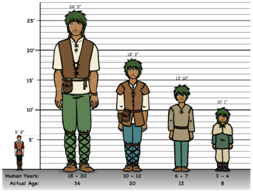
Lesson 5: Adjectives
In this section, we will take an in-depth look at the different types of adjectives and how they’re used in a sentence.
Objectives:
- To define adjectives
- To identify the different types of adjectives
- To define the different types of adjectives
- To use the different types of adjectives in a sentence
Quick Navigation through the Lesson 5:
It is very important when learning how to read and write well in English that you learn how to describe things properly. In this section, we’ll be talking about the kinds of words which describe people, things, places or events. These are called adjectives: we’ll be talking about the different types of adjectives and how they’re used in a sentence.
Definition
An adjective is a word in the English language used to modify or describe a noun.
Types
The basic form of an adjective is in a word used to describe a noun. For instance, words like pretty or funny are all adjectives if they’re used to describe a noun (as opposed to a verb, which we will talk about in the later lessons). In this section of our lesson, we’ll be discussing how these base adjectives can be altered to mean different things.
[WpProQuiz 107]
Comparative Adjectives
 We say that an adjective is comparative when it is used to contrast two things. Below we’ll study how to form these comparative adjectives in different cases.
We say that an adjective is comparative when it is used to contrast two things. Below we’ll study how to form these comparative adjectives in different cases.
i. Words with a single syllable
With words that only contain a single syllable, we simply add –er to the word.
For example,
old becomes older
young becomes younger
In a sentence, these examples would be used like this:
Anna is older than Gina.
Gina is younger than Anna.
Note that the adjective extends itself to the word than, which is always used when comparing two nouns. That way we describe not just Anna or Gina, but Anna and Gina as well as how they relate to each other in terms of age.
ii. Words with multiple syllables
If a word has multiple syllables, we don’t modify the spelling. Instead we use words like more, or less and add them to the base form of the adjective.
For example:
With the word beautiful, we don’t say beautifuler, we say more beautiful.
In a sentence, these are also accompanied by the word than to show how different nouns relate to one another in terms of the adjective.
For example:
Hello Panda is more delicious than Lays.
To denote a negative relationship, can add words like not as or less to the adjective.
For example:
Lays is not as delicious as Hello Panda.
Lays is less delicious than Hello Panda.
[WpProQuiz 108]
Superlative Adjectives
 An adjective is superlative if it compares more than two things and/or denotes the highest degree of the adjective. Words like best, most amazing, prettiest, most gorgeous, funniest are all superlative adjectives. In this part of our lesson, we’ll be taking a look at the different ways we can use superlatives.
An adjective is superlative if it compares more than two things and/or denotes the highest degree of the adjective. Words like best, most amazing, prettiest, most gorgeous, funniest are all superlative adjectives. In this part of our lesson, we’ll be taking a look at the different ways we can use superlatives.
Just like with comparative adjectives, we modify the base adjective to get to the superlative adjective. Only this time, we add –est instead of –er.
cute becomes cutest
loud becomes loudest
However, unlike its comparative counterpart, single-syllable superlatives aren’t accompanied by than, they’re accompanied by the.
Below are a couple of examples of how they behave in a sentence:
Andrew is the funniest boy in the group.
Letty is the tallest girl in class.
Also, with superlative sentences there is no set word with regard to syllabication as to how the base adjective will be modified. In most cases, -est is added but there are some cases where the adjective is not modified—instead, the word most is added to the base adjective. There is no set word for this, although usually longer words are modified in this way and not by adding –est.
For example:
Gianina is the most intelligent news anchor on that network.
Ronald is the most articulate poet I’ve ever met.
[WpProQuiz 109]
Putting It Together
Base, comparative and superlative adjectives are often used to show degree. Below are a couple of examples which show us how these three are used.
tall/taller/tallest
full/fuller/fullest
intelligent/more intelligent/most intelligent
not hungry/ less hungry/ least hungry
good/ better/ best
We can see how these words show either a higher (more, most) or less (less, least) degree. This will help make our sentences better and will help us make clear comparisons.
This section was all about adjectives or words that describe nouns. We learned about comparative adjectives, which make observations about two things in relation to each other. And we also learned about superlative adjectives which compare more than two things—we also learned the different ways to manipulate base adjectives to become either comparative or superlative. Moreover, we learned how these words modify or describe nouns.
Our next lesson will be about adverbs. These words are used to describe a verb, an adjective or another adverb. We’ll be taking a look at specific examples and the different types of adverbs that we might encounter. Keep reading and we’ll be another step closer to achieving great grammar.
 + 1-888-827-0150
+ 1-888-827-0150 + 44-20-3006-2750
+ 44-20-3006-2750










